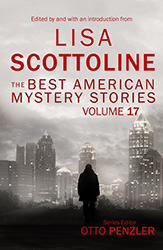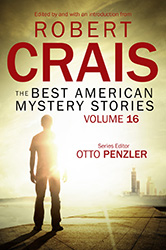The Best American Mystery Stories, Volume 17 (66 page)
Read The Best American Mystery Stories, Volume 17 Online
Authors: Lisa Scottoline

(Side note: No matter how strong the urge, no matter how enticing the temptation, no matter how freaking nostalgic you get for your sweet young lover from the good old days, DO NOT search for current photos of that lover on Facebook. Ewwwwww!)
Anyway, “The Indian” used to run to nearly 30,000 words. Janet Hutchings told me she would publish it if I cut it to under 20,000, which I could probably do just by taking out the f-words. I spent a few more of those words cursing silently, then started cutting.
I had intended to use this space to say something about how much I love to write novellas and why don't more places publish them, something about how “The Indian” is an elegy to small-town life, something about what an idiot my former dean of liberal arts is, and, finally, to direct a few hundred expletives at the pompous Magoos who continue to insist that genre fiction cannot be literary... but it looks like I've already used up my miserly ration of page space. F**k!
Â
Patricia Smith
is the author of six books of poetry, including
Blood Dazzler
, a finalist for the National Book Award, and her latest,
Shoulda Been Jimi Savannah
. Her work has appeared in
Poetry
, the
Paris Review, TriQuarterly, Tin House
, and both
Best American Poetry
and
Best American Essays
. She was the editor of
Staten Island Noir
, in which “When They Are Done with Us” appears; the story won the Robert L. Fish Award from the Mystery Writers of America for the best debut story of the year. She is a 2012 fellow at both the MacDowell Colony and Yaddo, a two-time Pushcart Prize winner, and a four-time individual champion of the National Poetry Slam, the most successful poet in the competition's history. A professor at the College of Staten Island and in the MFA program at Sierra Nevada College, Patricia is married to Edgar Award winner Bruce DeSilva, author of the Mulligan crime novels.
⢠  “When They Are Done with Us” has at its center a true Staten Island story that dominated the news for days. After a fire, the bodies of a mother and her four children were discovered. The throats of the mother and three of her children were slit, and near her thirteen-year-old son's body was a razor and a note with the scrawled words
am sorry
. The assumption was that he had killed his family and then committed suicide by sliding a blade across his own throat. People were horrified; hastily penned editorials screeched about young black boys and their frightening dysfunctions. Later it was discovered that it was the mother who had written the note and effectively framed her son for the killings.
As a writer with a fierce curiosity about all the ways the world goes awry, I couldn't push the story from my head. When I decided to write a piece for
Staten Island Noir
, I saw my chance to process the horror.
It happened in Port Richmond, a diverse but divided community, so this was initially a story about race: Jo, a white woman uncertain of her rooting, never quite sure how to respond or relate to her black and Latino neighbors, wrestles with feelings of disconnect and guilt when the tragedy occurs directly across the street from where she lives.
But once her teenage son, Charlie, walked in and opened his mouth, I immediately saw another direction for the story. He started as a bit player, a chalk outline, but he urged me to step back and see just how poisonous he could be. He allowed me to develop a tension created by those dueling levels of familiar violence and to make Jo's options, her space in this world, smaller and smaller, until her horrible choice was inevitable. Charlie created the reason for the necessary bond between Jo and Leisa, the woman who'd murdered her children and killed herself.
Since I primarily identify as a poet and this was the first short story I've ever written, I chose poetry as Jo's lifeline, her one shot at sanity and salvation. Having poetry be a part of the story linked the two genres and kept those voices (“Whatta ya think you're doin'? You don't know how to write a short story!”) at bay.
Â
Ben Stroud
is the author of the story collection
Byzantium
. His short stories have appeared in
Harper's Magazine, One Story, Electric Literature
, the
Boston Review
, and the anthology
New Stories from the South 2010
. He lives in Ohio and teaches at the University of Toledo.
⢠  I drafted this story over a cold January weekend in Michigan in 2007. While researching another story, I came across a rumor in a history of Havana about vagabonds who came to the city and started selling “French sausage” in the marketâsausage that was eventually discovered to be made of slaves who'd been kidnapped and murdered. Whether this truly happened, I don't know, but the rumor stuck with me for a few months (it was too good, too rich with thematic and dramatic possibility), until that cold weekend. I wanted to get as far from Michigan as possible and so decided it was time to write about Havana. I started with the rumor about the sausage and built the story out from there. How would the truth be discovered? I'd need a detective. Who would be the ideal detective? Someone who could pass through the different racial worlds of nineteenth-century Cuba. This is how I came up with the character of Burke, who appears in another of my stories as well. That he is an American rather than a Cuban is a result of my own ignorance. I didn't know enough about Cuba to pull off inhabiting a Cuban, so I made him a newcomer to the city. He would mirror me, also a newcomer.
In writing the story, I ended up doing far more research than reading that initial history. I even tracked down a tourist's map from the 1850s with fold-out views of the city (this I found in the University of Michigan Library's Special Collections). The story became a novella. Then it became the first section of a novel. And then, after five years, it became a story again. I didn't plan it that wayâit was a blind search all the way throughâbut it took that long process of growing and cutting away and leaving the story aside and coming back to it for it to finally become what it needed to be.
Â
Hannah Tinti
's story collection,
Animal Crackers
, has sold in sixteen countries and was a runner-up for the PEN/Hemingway Award. Her best-selling novel,
The Good Thief
, is a
New York Times
Notable Book of the Year, recipient of the American Library Association's Alex Award, winner of the Center for Fiction's First Novel Prize, and winner of the Quality Paperback Book Club's New Voices Award. Hannah is also cofounder and editor-in-chief of
One Story
magazine and received the PEN/Nora Magid Award for excellence in magazine editing. Recently she joined the Public Radio program
Selected Shorts
as its literary commentator.
⢠  I based “Bullet Number Two” on an experience I had while driving through the Four Corners. I got caught in a dust storm, just as Hawley does in the story, and had to pull over at a strange motel run by Navajos. There wasn't a shootout, but my room did have a hole punched through the wall. The storm was wild, and the sand and the colors and the light of the desert in the morning stayed with me. I'm grateful to
Tin House
for taking a chance and running this story, and to
Best American Mystery Stories
for giving it a second life.
Â
Maurine Dallas Watkins
(1896ââ1969) wrote the 1926 play
Chicago
, on which the musical is based. Winner of six Tonys and a Best Picture Oscar for the 2002 film, Watkins based her Broadway-bound play on the newspaper articles that she wrote as a young crime reporter for the
Chicago Tribune
while covering the sensationalist murder trials that rocked 1920s Chicago. Her tongue-in-cheek features on the “beautiful murderesses” turned media darlings were the inspiration for
Chicago
's Roxie Hart and Velma Kelly. Watkins wrote several other plays, including the long-lost
Revelry
, about the scandal-ridden White House of President Warren G. Harding, and the acidly cynical farce
So Help Me God!
, which received its first production in 2009, eighty years after its creation. She wrote or contributed to several films, including two Best Picture nominees,
Libeled Lady
and
Up the River
, as well as such screwball comedies as
Professional Sweethearts, No Man of Her Own
, and
I Love You Again
.

These short stories are like shots of espresso â best downed in one go and guaranteed to leave the heart racing. Hand-picked by bestselling author Lisa Scottoline, they showcase the best of contemporary crime-writing, from masters of suspense and stars of the future alike. Whether ingenious detective story or hardboiled noir, action-packed thriller or stylish historical mystery, these twenty stand-out stories should form the cornerstone of any crime reader's library.
Michael Connelly fans will be thrilled to find a Harry Bosch story, “A Fine Mist of Blood,” in which the LAPD detective tracks a cold case to a very warm conclusion.

The Best American Mystery Stories: Volume 16
These short stories are like shots of espresso â best downed in one go and guaranteed to leave the heart racing. Hand-picked by bestselling author Robert Crais, they showcase the best of contemporary crime-writing, from masters of suspense and stars of the future alike. Whether ingenious detective story or hardboiled noir, action-packed thriller or stylish historical mystery, these twenty stand-out stories should form the cornerstone of any crime reader's library.
Stories from: Tom Andes, Peter Beagle, K.L. Cook, Jason De Young, Joe Donnelly & Harry Shannon, Kathleen Ford, Mary Gaitskill, Jesse Goolsby, Katherine Hester, Thomas McGuane, Lou Manfredo, Nathan Oates, Gina Paoli, T. Jefferson Parker, Thomas J. Rice, Kristine Kathryn Rusch, Lones Seiber, Charles Todd, Tim L. Williams, Daniel Woodrell.
The Best American Mystery Stories: Volume 16
is available
here
.
A
LLYN
, J
IM
The Deer Woods.
Ellery Queen's Mystery Magazine
, February
A
PPEL
, J
ACOB
M.
Canvassing.
SubTropics
, Spring/Summer
A
RVEDON
, R
ICHARD
We Lived in Paradise.
13 Stories from the West Hartford Fiction Writers Group
Â
B
OHEN
, L
ES
Poseidiana.
Popcorn Fiction
B
ROWN
, K
AREN
The Philter.
Crazyhorse
, Spring
Â
C
HILD
, L
EE
The Hollywood to Remember.
Vengeance
, ed. Lee Child (Mulholland)
C
LEVELAND
, J
ANE
Last Supper.
Alfred Hitchcock's Mystery Magazine
, June
C
ONLEY
, J
EN
Finn's Missing Sister.
Needle
, Winter
Â
D
ANIEL
, R
AY
Driving Miss Rachel.
Blood Moon: Best New England Crime Stories
(Level Best)
D
OAK
, E
MILY
Hatchlings.
Crazyhorse
, Spring
D
ONOGHUE
, E
MMA
The Widow's Cruse.
One Story
, no. 168
Â
E
STLEMAN
, L
OREN
D.
